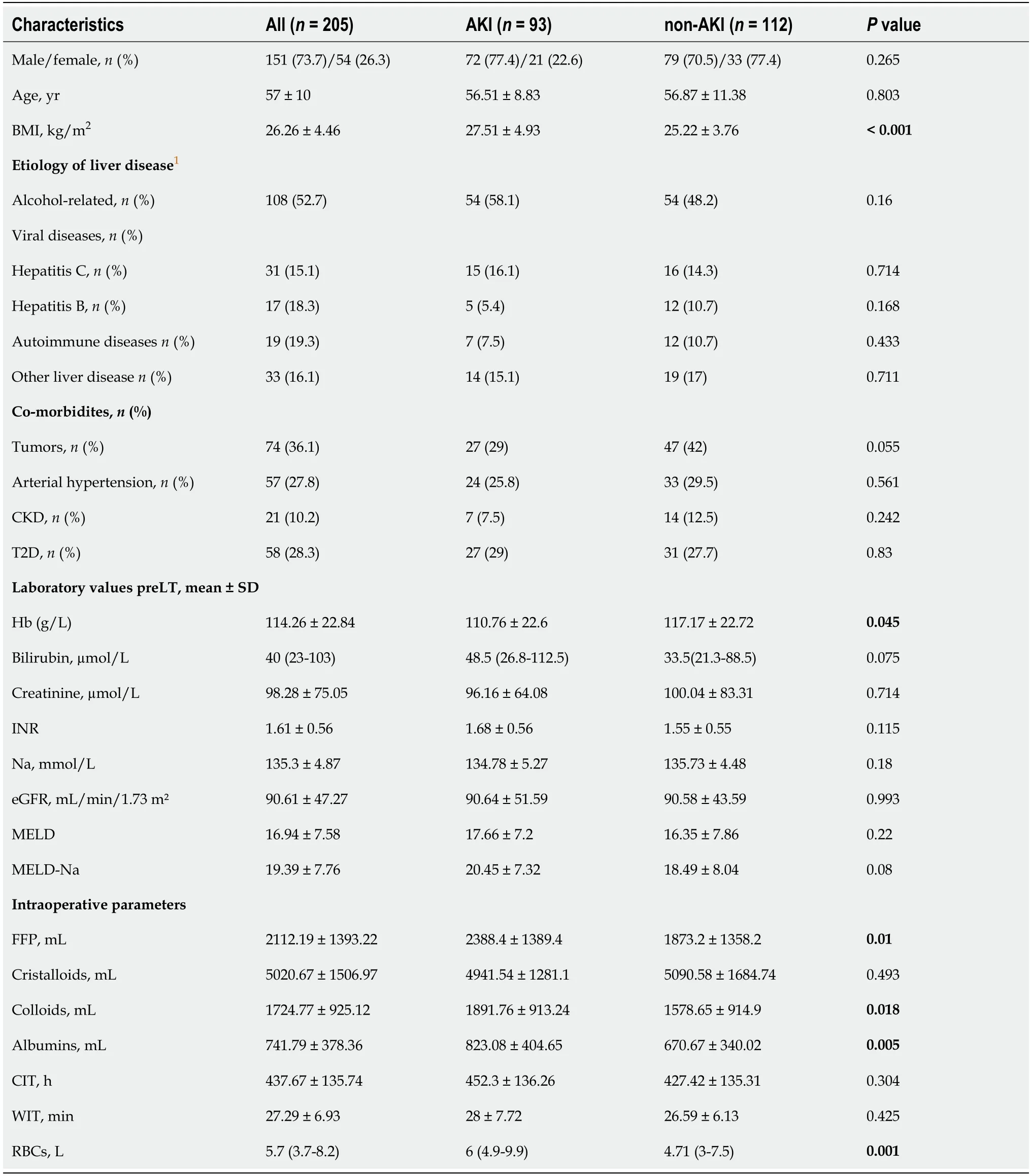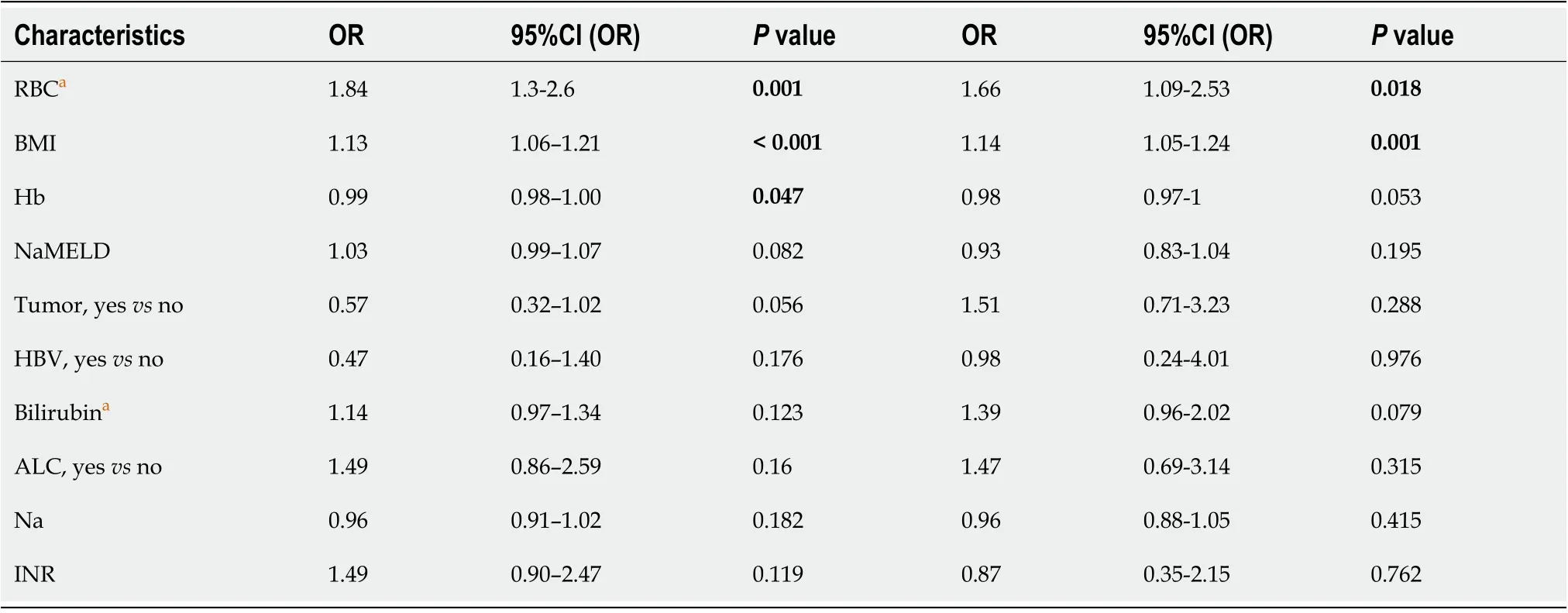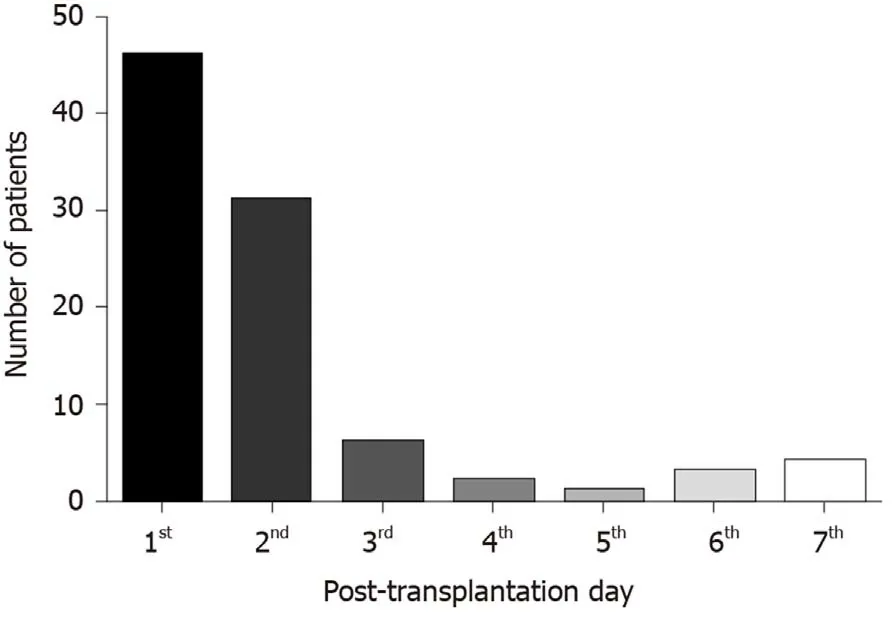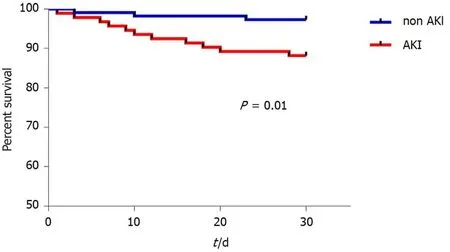Pre- and intraoperative predictors of acute kidney injury after liver transplantation
2020-04-08AnnaMrzljakLucijaFranusicJadrankaPavicicSaricTomislavKelavaZeljkaJurekovicBranislavKocmanDankoMikulicIvanBudimirBekanMladenKnotek
Anna Mrzljak,Lucija Franusic,Jadranka Pavicic-Saric,Tomislav Kelava,Zeljka Jurekovic,Branislav Kocman,Danko Mikulic,Ivan Budimir-Bekan,Mladen Knotek
Anna Mrzljak,Mladen Knotek,Department of Medicine,Merkur University Hospital,School of Medicine,University of Zagreb,Zagreb 10000,Croatia
Lucija Franusic,General Hospital Dubrovnik,Dubrovnik 20000,Croatia
Jadranka Pavicic-Saric,Department of Anesthesiology and Intensive Medicine,Merkur University Hospital,School of Medicine,University of Zagreb,Zagreb 10000,Croatia
Tomislav Kelava,Laboratory for Molecular Immunology,Croatian Institute for Brain Research,University of Zagreb,School of Medicine,Zagreb 10000,Croatia
Zeljka Jurekovic,Department of Medicine,Merkur University Hospital,Zagreb 10000,Croatia
Branislav Kocman,Danko Mikulic,Ivan Budimir-Bekan,Department of Surgery,Merkur University Hospital,Zagreb 10000,Croatia
Abstract BACKGROUND Acute kidney injury(AKI)after liver transplantation(LT)is a frequent and multifactorial event related to increased morbidity and mortality.Risk factors for AKI after LT still need to be clarified.AIM To identify the predictors of acute kidney injury after liver transplantation.METHODS The frequency and pre- and intraoperative predictors of AKI within the first 7 d after LT were evaluated in adult liver transplant candidates in a single LT center in Croatia.AKI was defined according to the Kidney Disease:Improving Global Outcomes criteria.RESULTS Out of 205 patients(mean age 57 ± 10 years;73.7% males,52.7% with alcoholrelated liver disease)93(45.36%)developed AKI,and the majority of them(58.06%)had stage 1.Only 5.38% of patients required renal replacement therapy after LT.The majority of patients(82.8%)developed AKI within the first two days after the procedure.Multivariate logistic regression identified pre-LT body mass index(OR = 1.1,95%CI:1.05-1.24)and red blood cell transfusion(OR = 1.66,95%CI:1.09-2.53)as independent predictors of early post-LT AKI occurrence.30-d survival after LT was significantly better for patients without AKI(P = 0.01).CONCLUSION Early AKI after LT is a frequent event that negatively impacts short-term survival.The pathogenesis of AKI is multifactorial,but pre-LT BMI and intraoperative volume shifts are major contributors.
Key Words:Acute kidney injury;Liver transplant;Body mass index;Red blood cell;Survival
INTRODUCTION
There has been an increasing interest in acute kidney injury(AKI)in the setting of liver transplantation(LT),in particular given its high incidence rates up to 60% and its unfavourable prognosis.AKI after LT encompasses a heterogeneous group of events,differing in etiology,reversibility of kidney damage,and short- and long-term consequences.
Post-transplant AKI has been associated with increased acute rejection rates,infectious complications,prolonged hospital stays,and higher hospital costs[1-5].In particular,AKI has been associated with the development of chronic kidney disease(CKD)and poorer long-term graft and/or patient survival[6,7].In addition,posttransplant CKD is independently associated with late mortality and cardiovascular events[8,9].
According to the International Registry in Organ Donation and Transplantation,in the last five years(2014-2019),Croatia has one of the highest liver transplantation rates in the world,estimated between 27.35-32.2 per million population[10].As the transplant population increases,it is of paramount importance to address multiple modifiable short and long-term risk factors out of which kidney disease has a significant influence on post-transplant outcomes.
The study aims to assess the frequency and pre- and intraoperative predictors of AKI within the first 7 d after LT and its impact on the short-term outcome in a single high-volume liver transplant center in Croatia.
MATERIALS AND METHODS
Patients
All consecutive adult patients who underwent primary,deceased-donor liver transplantation between October 2014 and October 2016 at Merkur University Hospital(MUH),Zagreb,Croatia were included in the study.Patients with prior solid-organ transplants,candidates for simultaneous liver-kidney transplants,and patients on dialysis before LT were excluded.MUH is a high-volume transplant center with approximately 120 liver transplants performed per year,representing over 90% of the LT program in the country[11].Patients’ clinical and laboratory data were retrospectively retrieved from the Electronic Medical Records.Approval for the study was obtained from the Hospital Ethics Committee.
Characteristics
The primary outcome measure was AKI.Post-transplant AKI was defined according to the Kidney Disease:Improving Global Outcomes(KDIGO)criteria[12];an increase in serum creatinine by ≥ 26.5 μmol/L within 48 h or an increase in creatinine to ≥ 1.5 times baseline within the first 7 post-operative days.AKI was classified into three stages:stage 1,creatinine increase to ≥ 26.5 μmol/L or increase to 1.5-1.9-fold from baseline;stage 2,increase to 2-2.9-fold;stage 3,increase > 3-fold or increase in serum creatinine to ≥ 354 μmol/L or the initiation of renal replacement therapy(RRT).
Preoperative and intraoperative parameters were used to predict AKI after LT and they included age,gender,primary diagnosis,co-morbidities before LT,and Model for End-Stage Liver Disease(MELD).MELD was calculated according to formula:MELDScore = 10*((0.957*ln(Creatinine))+(0.378*ln(Bilirubin))+(1.12*ln(INR)))+6.43 available at:https://reference.medscape.com/calculator/meld-score-end-stage-liverdisease[13].The last laboratory values for bilirubin,sodium and creatinine levels and international normalized ratio(INR)were obtained before transplant.We determined the estimated GFR(eGFR)using the Abbreviated Modification of Diet in Renal Disease(aMDRD)formula:eGFR = 186 ×(SCr mg dl-1)-1.154× age-0.203× 0.742 if a patient is female× 1.21[14].All biochemical parameters were analyzed in an accredited(ISO 15189:2012“Medical laboratories -- Requirements for quality and competence”)clinical laboratory.
Chronic kidney disease was defined as histology-proven kidney disease and/or the presence of pathological proteinuria or erythrocyturia and/or eGFR < 60 mL/min/1.732 calculated by the aMDRD formula,for at least three months before LT.
According to our center protocol,whenever not contraindicated(most frequently because of uncorrectable coagulopathy),kidney biopsies were performed in patients with suspected parenchymal renal disease(e.g.,proteinuria > 1 g/d and/or glomerular erythrocyturia),or in patients with stage 3-4 chronic kidney disease to determine the extent of interstitial fibrosis/tubule atrophy(IF/TA)and global glomerulosclerosis,as criteria for simultaneous liver and kidney transplantation.Patients with IF/TA,or glomerulosclerosis > 30% were considered candidates for liver and kidney transplants.
In addition,warm and cold ischemia time,intraoperative parameters of red blood cells(RBCs)transfusion(homologous and/or autologous),fresh frozen plasma(FFP),and total fluids were analyzed.Postoperative data;creatinine levels,RRT,date of death were used to define the end-point and outcome analysis within 30 days after liver transplant.
All patients underwent first-time orthotopic liver transplantation with whole grafts from donors after brain death(DBD)using the piggy back technique without venovenous bypass.If autologous RBC transfusion was used,cell salvage technique was employed:The blood was collected from the suction,surgical drains,or both and re-transfused back to the patient after filtration or washing.
Immunosuppression was provided per standard hospital protocol using triple immunosuppressive regimens.Methylprednisolone(500 mg)was given before reperfusion of the graft,followed by a gradual taper until 20 mg by the end of the first week.The oral dose for mycophenolate mofetil was 1 gram twice a day in combination with tacrolimus or cyclosporine(at the discretion of the transplant physician)starting within the first 24 h post-LT.The initial oral dose of tacrolimus or cyclosporine was 0.5 mg or 25 mg twice a day,respectively,starting within the first 24 h post-LT.Daily blood trough levels guided subsequent dosing with a targeted level of 8-10 mg/dL or 150-200 μg/dL for tacrolimus and cyclosporine,respectively.In addition to immunosuppression,all patients received antimicrobial prophylaxis in the form of amoxicillin and clavulanic acid or piperacillin tazobactam for 48 h after LT,followed by valganciclovir 450 mg once daily and trimethoprim-sulphomethoxasole 480 mg three times per week,starting within the first week.
Statistical analysis
Statistical analysis was performed using MedCalc and GraphPad Prism.Differences between the groups were tested usingχ2- and Fischer’s exact test(categorical variables)or Student'st-test and Mann-WhitneyUtests(ordinal or numerical variables).The strength of the association between AKI and potential risk factors was tested using univariate and multivariate logistic regression.Two variables that did not follow a normal distribution(RBC and bilirubin)were logarithmized(base 2)to achieve normal distribution before inclusion to multivariate analysis.The Kaplan-Meier method was used to estimate patient survival;the log-rank test was used to compare survival between patients with or without early post-transplant AKI.The level of statistical significance was set at α = 0.05.
RESULTS
In the study period,234 patients underwent liver transplantation,out of which 205 were included.Twenty-six patients did not meet inclusion criteria(3 on dialysis before LT).The mean age of the cohort was 57 ± 10 years;151(73.7%)were males,and alcohol-related liver disease 108(52.7%)was the main etiology.At the time of transplant,more than one-third of the patients 74(36.1%)had accompanying liver tumors,almost one third had type 2 diabetes(T2D)58(28.3 %),and arterial hypertension 57(27.8%)and 21(10.2%)had chronic kidney disease.The characteristics of the patients are presented in Table 1.
Within the first 7 d after liver transplant,acute kidney injury developed in 93(45.36%)of patients.The distribution of the stages of AKI is presented in Table 2.The majority of patients,54(58.06%),had stage 1.Only 5(5.38%)patients required renal replacement therapy within the first week after LT.The majority of patients(82.8%)developed AKI within the first two days after the procedure,Figure 1.
Patients who developed AKI had higher BMI pre-LT(27.51 ± 4.93vs25.22 ± 3.76,P<0.001),and higher intraoperative blood loss reflected in the requirements of red blood cell transfusion(P= 0.001),fresh frozen plasma(P= 0.01),albumin(P= 0.005),and colloids(P=0.018)during the procedure(Table 1).There were no differences between the groups regarding age,gender,etiology of liver disease,co-morbidities,preoperative laboratory parameters or cold and warm ischemia times(Table 1).In univariate logistic regression,factors associated with AKI within the first 7 days after LT were pre-LT BMI(P< 0.001),pre-LT hemoglobin(P= 0.047),and intraoperative RBC transfusion(P= 0.001).Multivariate logistic regression identified pre-LT BMI(OR= 1.1,95%CI:1.05-1.24)and RBCs transfusion(OR = 1.66,95%CI:1.09-2.53)as independent predictors of early post-LT AKI occurrence(Table 3).30-d patient survival after LT was significantly better in patients without AKI(log-rank,P= 0.01)(Figure 2).
DISCUSSION
Our study showed that in the early postoperative period,AKI represents a significant clinical burden in transplant recipients,as almost half of them(47.8%)developed some stage of acute kidney injury.However,the majority(54.1%)had stage 1 AKI,and only 2.4% patients required renal replacement therapy within the first week after LT.Similar extent of kidney injury was noted in previous studies which demonstrated that every second liver recipient encountered at least transient renal injury early after transplantation[15,16].
Post-transplant AKI likely results from a combination of pre-transplant and procedure-related events,in addition to post-transplant interventions(e.g.,immunosuppression).We assessed pre- and intra-operative parameters and showed that patients who developed AKI had significantly higher pre-LT BMI,lower pre-LT hemoglobin and higher intraprocedural requirements of red blood cells,fresh frozen plasma,albumin and colloids reflecting in particular severity of the disease and demanding procedure-related events.However,the differences regarding MELD scores,etiology of liver disease,co-morbidities,cold and warm ischemia times,in addition to age and gender between patients with and without AKI did not reach statistical significance.Previous studies have shown that patients with high MELD score at the time of transplant are at higher risk of developing AKI after the transplant[1,17].Namely,the severity of the liver disease is associated with post-LT AKI[17],as decompensated liver patients are more susceptible to kidney ischemia by the activation of endogenous vasoactive substances released during the procedure[18].Given Croatia’s high liver transplantation rates,the average MELD score at the time of transplant is low(MELD 16.94 ± 7.58,Table 1),and the waiting time is short.High laboratory MELD patients,as well as the patients who are prioritized(standard exception)according to the Eurotransplant allocation system(e.g.,hepatocellularcarcinoma)[19],have particularly short waiting times.Therefore,in general,our liver patients are not “too sick” at the time of transplant,which favourably influences the outcomes and might have led to observed lack of association of the MELD with AKI in our study.The majority of our patients(82.8%)developed AKI within the first two days after the procedure implicating that procedure-related events are the major determinants in the development of early AKI.Indeed,any event during theprocedure resulting in kidney hypoperfusion may result in post-LT AKI[20].From our data,it is difficult to assess the etiopathogenesis of AKI in our cohort.Presumably,a significant proportion of patients developed pre-renal azotemia,due to large intraoperative fluid shifts and blood loss(as evidenced by the relationship between AKI and RBCs transfusion),with rapid renal function improvement in the early postoperative period.On the other hand,transfusion of RBCs may play an additional role in AKI development by inducing a pro-inflammatory state and increasing the concentrations of nephrotoxic free hemoglobin and iron[21,22].

Table 1 Characteristic of the total patient cohort with differences between acute kidney injury and non-acute kidney injury patients within first 7 d after liver transplantation

Table 2 Distribution of stages of acute kidney injury after liver transplantation

Table 3 Univariate and multivariate logistic regression;factors associated with acute kidney injury occurrence within 7 d after liver transplantation
In our study,in addition to transfusion of RBCs,the pre-transplant BMI has been identified as an independent predictor of AKI in the early post-LT period.A substantial body of evidence supports that higher body mass index in critically ill patients is associated with the development of AKI and increased short- and long-term mortality[23-25].However,this should be taken with caution in patients with end-stage liver disease,as BMI is limited by the inability to assess body composition(the relative proportions of fat and lean mass),and even more so in patients with decompensated cirrhosis where further limitations arise from fluid retention[26].Indeed,Leonard and colleagues showed on 1313 patients awaiting LT that after correction for ascites volume,11%-20% of patients fall into a lower BMI classification and that BMI can no longer serve as an independent predictor of a post-transplant patient or graft survival[27].In our study,it is interesting that decreased pre-transplant kidney function was not related to the development of subsequent AKI,unlike some previous reports,where pre-transplant AKI or CKD were risk factors for post-transplant AKI[28,29].

Figure 1 The onset of acute kidney injury after liver transplantation according to post-operative days.

Figure 2 One month patient survival after liver transplantation:Patients with acute kidney injury vs patients without acute kidney injury(log rank,P = 0.01).AKI:Acute kidney injury.
AKI,as a risk factor for mortality after LT,needs more investigation.Although it is clear from our results that the patients who developed AKI had lower 30-d survival,further research is required to assess whether AKI is an independent causative factor contributing to decreased survival.Similarly,the long-term risk of developing CKD needs to be evaluated in patients with post-transplant kidney injury.
Our study has several limitations that need to be pointed out.This is a retrospective study.The majority of patients were male,and the leading etiology was alcoholic liver disease,representing a typical LT population in Croatia.Also,the study did not include donor-related parameters,which might have contributed to the AKI occurrence.The use of nephrotoxic drugs was not explicitly analysed,but our center tends to avoid pre-transplant or post-transplant use of nephrotoxic drugs.No kidney histology data are included.Special care is taken to avoid nephrotoxic drugs in patients with renal impairment,as stated in our protocol in the Methods.In addition,the lack of an exact measure of body constitution and a more precise assessment of kidney function by creatinine clearance in end-stage liver disease patients can be regarded as important study limitations.
CONCLUSION
In conclusion,despite these limitations,our study offers valuable insight into the epidemiology of AKI and identifies potential risk factors for its development after liver transplantation.Early AKI after LT is a frequent event that negatively impacts shortterm survival.The pathogenesis of AKI is multifactorial,but pre-LT BMI and intraoperative volume shifts are major contributors.
ARTICLE HIGHLIGHTS
Research background
Acute kidney injury(AKI)after liver transplantation(LT)is a frequent and multifactorial event related to increased morbidity and mortality.
Research motivation
Risk factors for AKI after LT still need to be clarified.
Research objectives
To identify the predictors of acute kidney injury after liver transplantation.
Research methods
The frequency and pre- and intraoperative predictors of AKI within the first 7 d after LT were evaluated in adult liver transplant candidates in a single LT center in Croatia.AKI was defined according to the Kidney Disease:Improving Global Outcomes criteria.
Research results
Out of 205 patients,45.36% developed AKI,and the majority of them(58.06%)had stage 1.Only 5.38% of patients required renal replacement therapy after LT.Pre-LT body mass index(OR = 1.1,95%CI:1.05-1.24)and red blood cell transfusion(OR =1.66,95%CI:1.09-2.53)were identified as independent predictors of early post-LT AKI occurrence.30-d survival after LT was significantly better for patients without AKI(P= 0.01).
Research conclusions
Early AKI after LT is a frequent event that negatively impacts short-term survival.The pathogenesis of AKI is multifactorial,but pre-LT BMI and intraoperative volume shifts are major contributors.
Research perspectives
Acute kidney injury,as a risk factor for mortality after LT,needs more investigation.Although it is clear from our results that the patients who developed AKI had lower 30-d survival,further research is required to assess whether AKI is an independent causative factor contributing to decreased survival.Similarly,the long-term risk of developing CKD needs to be evaluated in patients with post-transplant kidney injury.
杂志排行
World Journal of Clinical Cases的其它文章
- Special features of SARS-CoV-2 in daily practice
- Gastrointestinal insights during the COVID-19 epidemic
- From infections to autoimmunity:Diagnostic challenges in common variable immunodeficiency
- One disease,many faces-typical and atypical presentations of SARS-CoV-2 infection-related COVID-19 disease
- Application of artificial neural networks in detection and diagnosis of gastrointestinal and liver tumors
- Hepatic epithelioid hemangioendothelioma:Update on diagnosis and therapy
